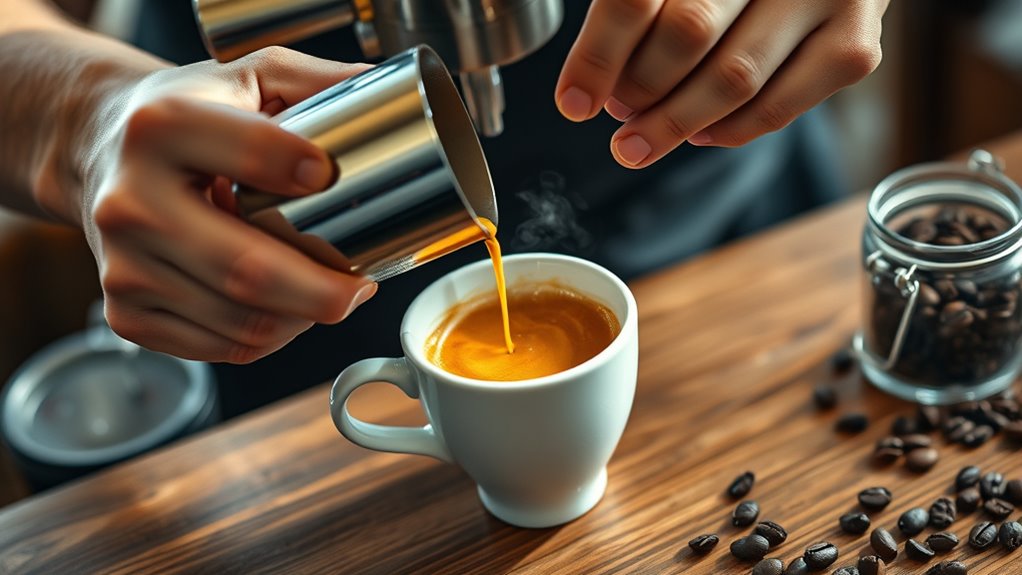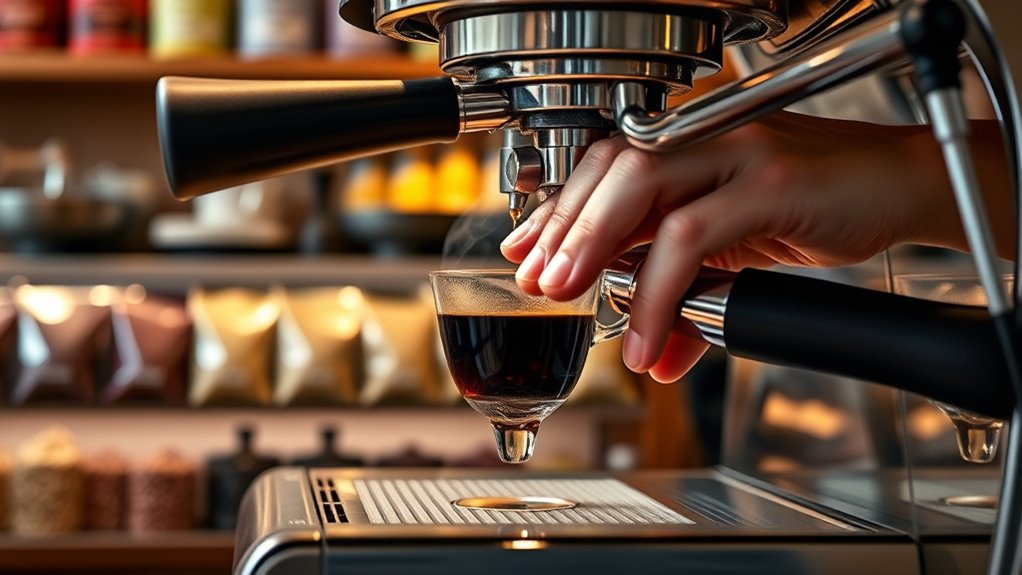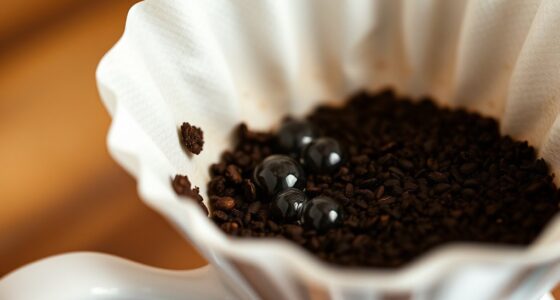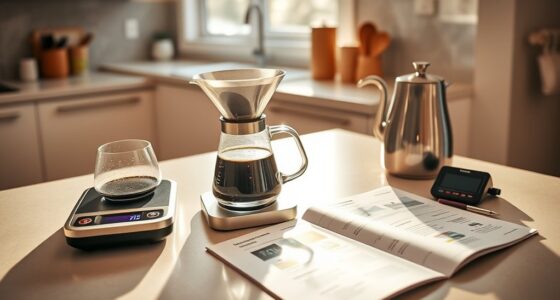To quickly improve your single origin brew, focus on adjusting grind size, water temperature, and brew time to highlight its unique regional flavors and brightness. For blends, increase extraction by using a coarser grind and slightly higher temperature to maximize smoothness and body. Small tweaks can make a big difference in clarity or richness. Keep experimenting with these variables to perfect each brew—continue exploring, and you’ll reveal even more flavor nuances.
Key Takeaways
- Adjust grind size: medium-fine for single origin to enhance clarity, coarser for blends to boost body.
- Fine-tune water temperature: 195–200°F for single origin, slightly higher around 200–205°F for blends.
- Modify brew time: shorter for single origin to preserve brightness, longer for blends to develop smoothness.
- Select brewing method: pour-over for clarity, French press for fuller body and richness.
- Taste and refine: small tweaks in grind, temperature, or time can instantly improve flavor balance.
Quick Tips to Perfect Your Coffee Brew

Have you ever wondered how to quickly optimize your coffee brewing between a single origin and a blend? The key lies in understanding their distinct flavor profiles and adjusting your brewing techniques accordingly. Single origin coffees often showcase unique and nuanced flavors that highlight the specific region, elevation, and processing method. These coffees tend to have bright acidity, complex fruit notes, and a clean finish. Blends, on the other hand, combine beans from multiple origins to create a balanced, consistent flavor profile, often emphasizing smoothness and harmony over individual nuances.
Single origin highlights unique regional flavors; blends focus on smoothness and consistency.
To enhance your brewing for each type within just a few minutes, start by considering the flavor profiles you want to bring out. For single origins, you’ll want to focus on brewing methods that accentuate clarity and brightness. Pour-over or AeroPress are excellent choices because they allow precise control over variables like water temperature and extraction time. Use slightly lower temperatures around 195–200°F to preserve delicate floral or fruity notes. Grind your beans medium-fine, aiming for a balanced extraction that highlights the coffee’s unique characteristics without overpowering them. Additionally, paying attention to the visual clarity of your brew can help you gauge the extraction quality and enhance the overall flavor experience.
For blends, the goal is often to achieve a rich, full-bodied cup that emphasizes smoothness and consistency. French press or a coarser grind in drip brewing works well here, as they promote fuller extraction and a more robust mouthfeel. You can experiment with slightly higher brewing temperatures, around 200–205°F, to extract the harmonious flavors embedded in the blend. Adjust your grind size to coarser if you’re using immersion methods, which helps prevent over-extraction and maintains a balanced profile.
In just a few minutes, you can tweak your brewing technique to optimize your coffee experience. For single origin coffees, focus on controlling variables like grind size, water temperature, and brew time to highlight the coffee’s distinctive flavor profile. For blends, aim for methods that maximize body and consistency, such as longer steep times or coarser grinds. Remember, small adjustments can make a significant difference, so take note of what works best for each type and refine your process. Whether you prefer the clarity of a single origin or the comfort of a well-crafted blend, a quick tune-up to your brewing approach can elevate your coffee game instantly.
Frequently Asked Questions
How Do I Identify a Good Single Origin Coffee?
To identify a good single origin coffee, focus on its origin characteristics and flavor profiles. Look for detailed tasting notes that highlight unique flavors like fruitiness, acidity, or earthiness, which reflect its specific region. Trust reputable roasters who provide transparent sourcing info. Smell the aroma and taste a small brew; a good single origin should reveal complexity and distinctive qualities tied to its origin.
What Are Common Mistakes When Blending Coffee?
Ever poured a blend and wondered if the flavors clash? One common mistake is neglecting flavor balancing, which can result in a confusing cup. Also, without sourcing transparency, you might miss out on understanding how each bean impacts the final profile. To avoid these pitfalls, experiment carefully, keep track of your sources, and aim for harmony between the beans. That way, your blends will shine with complexity and clarity.
Can I Use the Same Brew Method for Both?
Yes, you can use the same brew method for both, but focus on maintaining brew consistency to guarantee each cup tastes its best. Using the same method helps preserve the unique flavors of single origin and blends, allowing their distinct qualities to shine through. However, you might want to tweak grind size or brew time slightly to optimize flavor preservation, especially if the beans’ characteristics differ markedly.
How Does Roast Level Affect Flavor in Blends Vs Single Origins?
Roast level considerably influences flavor complexity in both blends and single origins. A darker roast enhances body and boldness, making flavors more pronounced, while a lighter roast preserves the unique characteristics of the beans, highlighting their origin. The roast influence varies, but generally, lighter roasts reveal more nuanced, intricate flavors, whereas darker roasts offer a more straightforward, robust profile. Your choice depends on whether you prefer complexity or bold simplicity.
Is There a Best Time to Buy Fresh Coffee Beans?
You should buy fresh coffee beans when they’re in season, typically within a month of roasting, for maximum flavor. To keep them fresh, store your beans in an airtight container away from light, heat, and moisture. Seasonal purchasing helps you enjoy peak freshness, while proper storage tips prevent staling. Buying in small amounts regularly ensures you always have fresh beans and the best coffee experience.
Conclusion
Now that you’ve unblocked these simple tips, your coffee game will never be the same. But here’s the real question—are you ready to discover how these small tweaks can transform your entire experience? The secret lies in what you do next. With just a few more adjustments, you might find yourself savoring flavors you never knew existed. Don’t stop now—your perfect cup is closer than you think, waiting just beyond the next pour.










